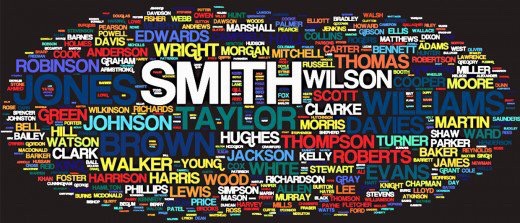We all have a surname, but how many of us know anything about its origin and history?
A major Arts and Humanities Research Council (AHRC) funded research project led by a team at the University of the West of England (UWE Bristol) have unveiled the UK and Ireland’s largest and most comprehensive collection of family names published by Oxford University Press.
Farah, Twelvetrees and Li (Lee) are amongst the 8000 family names explained for the first time ever, alongside corrections to previous explanations such as Starbuck and Hislop in the newly published Oxford Dictionary of Family Names in Britain and Ireland.
The result of a four year detailed investigation of the linguistic origins, history, and geographical distribution of 45,600 most frequent family names in Britain and Ireland, the print and online database, offers an explanation for all names from the very common to many rarer names with 100 current bearers.
Nearly 40,000 family names are native to Britain and Ireland, while the remainder reflect the diverse languages and cultures of immigrants that have settled from the sixteenth century to the present day: including French Huguenot, Dutch, Jewish, Indian, Muslim (Arabic), Korean, Japanese, Chinese and African.
Professor Patrick Hanks and Professor Richard Coates have led a team of eminent researchers including historical linguists, medieval historians, lexicographers and expert advisers on Irish, Scottish, Welsh and recent immigrant names. The team analysed records from published and unpublished sources dating from the 11th to the 19th century to enable new and detailed explanations of names that is much more reliable and up to date than those currently available.
Each entry includes the current and 1881 frequencies of the name, its main location in Britain and Ireland, its language or culture of origin and, wherever possible, an explanation supported by historical evidence for the name. Much of the evidence is new, drawn from previously untapped medieval and modern sources such as tax records, church registers, and census returns.
Professor Richard Coates, says, “There is widespread interest in family names and their history. Our research uses the most up-to-date evidence and techniques in order to create a more detailed and accurate resource than those currently available. We have paid particular attention, wherever possible, to linking family names to locations.
“Some surnames have origins that are occupational – obvious examples are Smith and Baker; less obvious ones are Beadle, Rutter, and Baxter. Other names can be linked to a place, for example Hill or Green (which relates to a village green). Surnames which are ‘patronymic’ are those which originally enshrined the father’s name – such as Jackson, or Jenkinson. There are also names where the origin describes the original bearer such as Brown, Short, or Thin – though Short may in fact be an ironic ‘nickname’ surname for a tall person.”
A new entry to the dictionary with two sources is the surname Farah, which has both an English and Muslim definition. The rare English name Farah, is recorded with five bearers in the 1881 Census, resident in Middlesex and northern England.
Its derived from the northern pronunciation of the much commoner Farrer, an occupational name from Middle English, ferrour ‘ironworker, blacksmith’, itself a borrowing of Old French ferreor. In contrast, there are many Muslim families with this name in present-day Britain (1,502 bearers in 2011) and is derived from the personal name based on the Arabic, farah meaning joy, happiness and delight.
Twelvetrees is a rare name, with 75 bearers recorded in the 1881 Census, mainly resident in Lincolnshire) and a variation of the name Twelftree (in 1881 a Northamptonshire and Bedfordshire surname) with an additional -s. The surname is thought to be an altered form, by folk etymology, of Weldrick, a locative surname from Wheldrake in the East Riding of Yorkshire. A gentry family with a surname from this place is recorded in Bedfordshire in the fourteenth century.
An immigrant surname fully explained for British and Irish readers for the first time is Li, often written Lee. This is one of the commonest Chinese surnames in Britain, with over 9000 bearers in 2011, not counting those who spell it Lee, which will multiply the number considerably. It has at least six different origins in a range of Chinese dialects, including ‘plum’, ‘chestnut’, ‘black’, ‘fortunate’, and ‘strict’.”
Another example of a recent immigrant surname is Patel, which has not been explained before in any dictionary covering the surnames of Britain and Ireland. It is one of the most common Indian surnames in Britain, with over 100,000 bearers in 2011. It is a status name from a Hindu and Parsi word for a village headman. There were 101,463 bearers in 2011.
Farraday, Vardy, Clutterbuck, Redknap, Stilgoe and Toynbee are also names that have not been explained in previous dictionaries.
A name that has previously been incorrectly explained in previous dictionaries is Hislop (1,630 bearers in 2011). Rather than originating from an unidentified place in northern England, this is a locative surname of Scottish origin (1,801 bearers in the 1881 census). It comes from a minor place called Hislop in Roxburghshire, on the banks of Hazelhope Burn, a tributary of Falnash Burn, which feeds into the river Teviot. The place-name, as well as Hazelhope Burn, derives from Middle English hasel ‘hazel’ + hop ‘deep enclosed valley’.
Dawkins, Hawkins, Palin and Starbuck have also been corrected in the dictionary.
Professor Patrick Hanks adds, “It’s only with computer technology for sorting and comparing hundreds of millions of digitised records that enough electronic data is available and organisable so as to enable researchers to draw conclusions with confidence about the origin and history of each surname taking account of factors such as its geographical distribution and local dialect. Thanks to historical and distributional evidence that was previously unavailable, we’ve also been able to explain hundreds of new surnames and correct many widely believed errors. FaNBI is a huge step forward in surname studies.”
Samuel Lambshead, Strategy and Development Manager at the Arts and Humanities Research Council, said, “This amazing four-year project collecting the origins of tens of thousands of family names in the UK and Ireland is a classic example of the impact and wider public benefit of high quality research. It will be a wonderful resource for generations to come.
“We’re all naturally fascinated about where our family names originate from and what meaning they might have. The boom in the last decade in genealogy and the popularity of TV programmes such as ‘Who Do You Think You Are?’ show that knowledge about the origins of family names is so important in helping to understand our own stories and mapping out those of our ancestors.”
The Oxford Dictionary of Family Names in Britain and Ireland is published on 17 November 2016 in hardback print format (four volumes), Ebook format and for library subscription online via Oxford Reference for a UK retail price of £400. The dictionary will be accessible for free via public libraries that purchase the resource.







